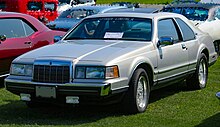
Lincoln Motor Company, or simply Lincoln, is the luxury vehicle division of American automobile manufacturer Ford Motor Company. Marketed among the top luxury vehicle brands in the United States, until 2020, Lincoln was positioned closely against its General Motors counterpart Cadillac; however, beginning with the 2021 model year, they only offer SUV and crossover vehicles.

The Lincoln Town Car is a model line of full-size luxury sedans that was marketed by the Lincoln division of the American automaker Ford Motor Company. Deriving its name from a limousine body style, Lincoln marketed the Town Car from 1981 to 2011, with the nameplate previously serving as the flagship trim of the Lincoln Continental. Produced across three generations for thirty model years, the Town Car was marketed directly against luxury sedans from Cadillac and Chrysler.

The Mercury Cougar is a series of automobiles that was sold by Mercury from 1967 to 2002. The model line is a diverse series of vehicles; though the Cougar nameplate is most commonly associated with two-door coupes, at various stages in its production, the model also was offered as a convertible and a hatchback. During its production as the mid-size Mercury line, the Cougar was also offered as a four-door sedan and five-door station wagon.
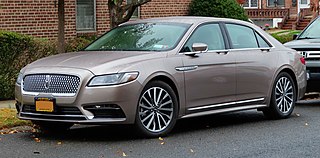
The Lincoln Continental is a series of mid-sized and full-sized luxury cars produced between 1939 and 2020 by Lincoln, a division of the American automaker Ford Motor Company. The model line was introduced following the construction of a personal vehicle for Edsel Ford, who commissioned a coachbuilt 1939 Lincoln-Zephyr convertible, developed as a vacation vehicle to attract potential Lincoln buyers. In what would give the model line its name, the exterior was given European "continental" styling elements, including a rear-mounted spare tire.
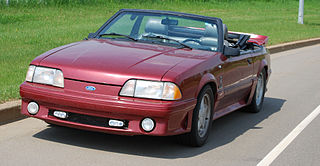
The Ford Fox platform is an automobile platform that was used by Ford Motor Company. Introduced for compact sedans in the 1978 model year, the Fox architecture was utilized for a wide variety of configurations for Ford and Lincoln-Mercury vehicles. In its original form, the platform was used through the 1993 model year; a substantial redesign of the Ford Mustang extended its life into the 21st century, ending production in 2004. Produced across 26 model years, the Fox platform is the second-longest car architecture ever designed by Ford Motor Company.
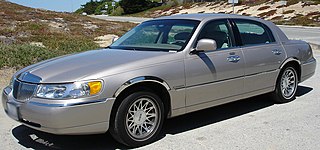
The Ford Panther platform was an automobile platform that was used by Ford Motor Company from the 1979 to 2012 model years. Following the downsizing of the General Motors B-bodies and C-bodies by two years, the Panther platform marked the end of production of sedans unencumbered by downsizing. Originally slated for discontinuation during the early 1980s, the Panther architecture was used for 33 model years, making it one of the longest-produced platforms in North American automotive history.

The Mercury Mountaineer is a mid-size luxury sport utility vehicle (SUV) that was sold by Mercury from 1996 until 2010. Sharing many of its features with the Ford Explorer, the vehicles were virtually identical in terms of hardware. Externally, they were styled somewhat differently, and the Mountaineer was positioned with a more upscale interior, with the Mountaineer's MSRP coming in at $1,000–$6,000 more than the Explorer. It was last redesigned for the 2006 model year with a new frame, looking very similar to its previous model.
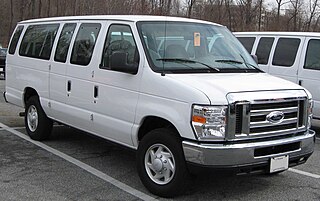
The Ford E-Series is a range of full-size vans manufactured and marketed by the Ford Motor Company. Introduced for 1961 as the replacement of the Ford F-Series panel van, four generations of the model line have been produced. Marketed for both cargo and passenger transport configurations, the E-Series has been designed with multiple design variations for both retail and commercial sale, including vans, and commercial-grade cutaway van chassis and stripped chassis.
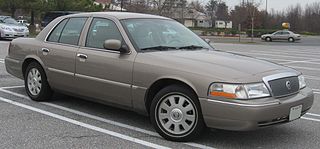
The Mercury Grand Marquis is an automobile that was sold by Mercury from 1975 to 2011. Introduced as the flagship sub-model of the Mercury Marquis, the Grand Marquis became a stand-alone model line for 1983, serving as the largest Mercury sedan. Subsequently, the model line would serve as the sedan counterpart of the Mercury Colony Park station wagon; it would later serve as the basis of the revived Mercury Marauder.
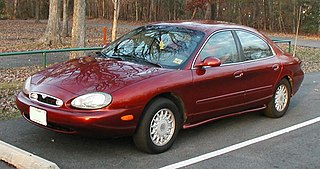
The Mercury Sable is a range of automobiles manufactured and marketed by the Mercury brand of Ford Motor Company. Introduced on December 26, 1985, as the replacement for the Mercury Marquis, the Sable marked the transition of the mid-size Mercury product range to front-wheel drive.

The Ford F-Series is a series of light-duty trucks marketed and manufactured by Ford Motor Company since the 1948 model year. The F-Series is marketed as a range of full-sized pickup trucks positioned above the midsize Ranger but below the larger Super Duty in the Ford truck lineup. Alongside the F-150, the F-Series also includes the Super Duty series, which includes the heavier-duty F-250 through F-450 pickups, F-450/F-550 chassis cabs, and F-600/F-650/F-750 Class 6–8 commercial trucks.

The Lincoln Navigator is a full-size luxury SUV marketed and sold by the Lincoln brand of Ford Motor Company since the 1998 model year. Sold primarily in North America, the Navigator is the Lincoln counterpart of the Ford Expedition. It is the heaviest production Lincoln ever built, and is also the Lincoln with the greatest cargo capacity and the first non-limousine Lincoln to offer seating for more than six people.

The LincolnMark VIII is a grand touring luxury sport coupe that was marketed by Lincoln from the 1993 to 1998 model years. The first generation of the Mark series branded entirely as a Lincoln, the Mark VIII again served as a counterpart of the Ford Thunderbird and Mercury Cougar. Though maintaining its traditional brand rivalry with the Cadillac Eldorado, the Mark VIII was also developed to become more competitive against luxury coupes from automakers around the world.

The Mercury Marquis is a model line of automobiles marketed by Mercury from 1967 to 1986. Deriving its name from a title of French nobility, the Marquis was introduced as the divisional counterpart of the Ford LTD; four generations of the two model lines were paired through rebranding. Initially slotted as the flagship Mercury full-size range, the Marquis would serve as the basis for the later Mercury Grand Marquis.
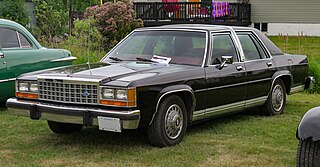
The Ford LTD Crown Victoria is a line of full-size cars that was manufactured and marketed by Ford from the 1980 to 1991 model years. Deriving its name from the Ford Fairlane coupe of 1955–1956, the LTD Crown Victoria served as the flagship of the Ford LTD model range in North America. Serving as the Ford counterpart of the Mercury Grand Marquis, the model line was offered as a two-door and a four-door sedan and a five-door station wagon.
The Continental Mark series is a series of personal luxury cars that was produced by Ford Motor Company. The nomenclature came into use with the Continental Mark II for 1956, which was a successor to the Lincoln Continental of 1939–1948. Following the discontinuation of the Mark II, Ford continued the use of the Mark series on Continental-branded vehicles from 1958 to 1960.

The Continental Mark VI is a full-size luxury car that was produced by Ford Motor Company from 1980 to 1983. The fifth generation of the Mark series, the Continental Mark VI introduced several changes to the model line. Again marketed and serviced by the Lincoln-Mercury division, the Mark VI served as the flagship of the entire Ford Motor Company model line, slotted above the Lincoln Town Car.

The ninth generation of the Ford Thunderbird is a personal luxury coupe that was manufactured and marketed by Ford for the 1983 to 1988 model years. In response to the sales downturn of the 1980–1982 Thunderbird, the model line underwent one of its most substantial redesigns for the 1983 model year. While the Thunderbird remained as a personal luxury coupe, Ford transitioned its role, emphasizing performance and handling over outright luxury and comfort content. As a design leader for Ford, the ninth-generation Thunderbird marked the introduction of highly aerodynamic body design for Ford vehicles in North America, followed by the 1984 Ford Mustang SVO and Ford Tempo and the 1986 Ford Aerostar and Ford Taurus.

The Ford B series is a bus chassis that was manufactured by the Ford Motor Company. Produced across six generations from 1948 to 1998, the B series was a variant of the medium-duty Ford F series. As a cowled-chassis design, the B series was a bare chassis aft of the firewall, intended for bodywork from a second-stage manufacturer. While primarily used for school bus applications in the United States and Canada, the chassis was exported worldwide to manufacturers to construct bus bodies for various uses.
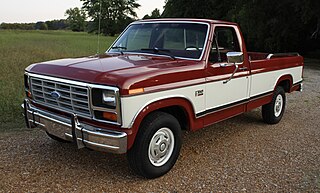
The seventh generation of the Ford F-Series is a range of trucks that was produced by Ford from the 1980 to 1986 model years. The first complete redesign of the F-Series since the 1965 model year, the seventh generation received a completely new chassis and body, distinguished by flatter body panels and a squarer grille, earning the nickname "bullnose" from enthusiasts. This generation marked several firsts for the model line, including the introduction of the Ford Blue Oval grille emblem, the introduction of a diesel engine to the model line, and a dashboard with a full set of instruments (optional). Conversely, this generation marked the end of the long-running F-100, the Ranger trim, and sealed-beam headlamps.


